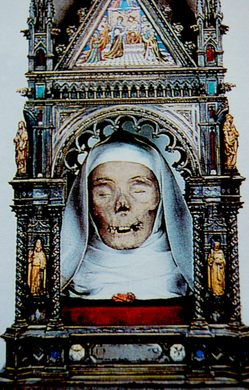Caterina di Giacomo di Benincasa was born on the feast of the Annunciation, March 25th, 1347, in the Fontebranda district of Siena, Italy, the twenty-fourth of twenty-five children. Her father was a dyer and her mother was the daughter of a local poet.
St. Catherine of Siena became deeply religious as a child and had visions that started when she was only 6 years old. Catherine joined the Third Order of the Dominicans (member of a monastic third order who takes simple vows and may remain outside a convent or monastery) as a teen.
She lived in a century when chaos ruled the Church and society. From 1375 onwards, she began dictating letters to scribes. These letters were intended to reach men and women of her circle, increasingly widening her audience to include figures in authority as she begged for peace between the republics and principalities of Italy and for the return of the Papacy from Avignon to Rome. She carried on a long correspondence with Pope Gregory XI, asking him to reform the clergy and the administration of the Papal States. Gregory did indeed return his administration to Rome in January 1377; to what extent this was due to Catherine's influence is a topic of much modern debate.
In 1378, the Great Schism began, splitting the allegiance of Christendom between two, then three, popes and putting even saints on opposing sides. Catherine spent the last two years of her life in Rome, in prayer and pleading on behalf of the cause of Pope Urban VI and the unity of the Church. She offered herself as a victim for the Church in its agony. St. Catherine died in Rome, in 1380, at the age of thirty-three.
Her hometown, Siena, wanted to have her body. When they realized they would not be able to smuggle the whole body past the guards in Rome, they took only her head, hidden in a paper bag. Catherine's mummified head and her right thumb are now both located at the Basilica San Domenico in Siena, Italy. Her three fingers and left foot are said to be in Venice, while a rib can be found in Florence. However, the rest of her body is said to be still in Rome.
St. Catherine of Siena was canonized by Pope Pius II in 1461, and named Patron Saint of Italy on May 5, 1940 by Pope Pius XII. She was given the title of Doctor of the Church in 1970 by Pope Paul VI. She is simultaneously the Patron Saint of Siena, the Patron Saint of Italy, and the Patron Saint of Europe, as proclaimed by St. John Paul II in October 1999.
St. Catherine of Siena is one of only four female “Doctors” of the Roman Catholic Church (St. Teresa of Avila, St. Therese of Lisieux, and St. Hildegard of Bingen are the other three). She is known as the Doctor of Unity for bringing about the union of the Papacy and returning it to Rome after nearly a century in France. St. Catherine dictated, under the inspiration of the Holy Spirit, four treatises called “The Dialogues.” She also wrote nearly four hundred letters and a series of prayers.


No comments:
Post a Comment